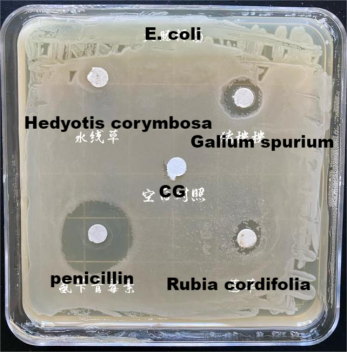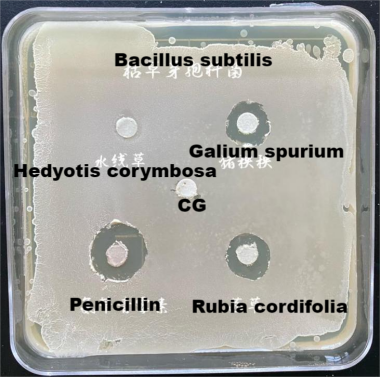1. Introduction
Microorganisms are ubiquitous and impact various aspects of life, such as bacteria that cause tuberculosis by invading the human body, fungi that cause various types of rashes, and fungal infections of crops that can affect food production. While Traditional Chinese Medicine (TCM), the experience-based medicine and medical knowledge accumulated by China over its 5,000-year history, has potential to address antimicrobial issues. According to TCM, many seemingly roadside weeds actually possess remarkable medicinal value. From the recorded plants, medicinal compounds have been extracted, such as artemisinin, with significant contributions to modern medicine, which suggests the considerable efficacy of TCM literature for the development of medicine.
Through the efforts of domestical and international scientists, many common Chinese herbs have been confirmed to contain medicinal substances or exhibit antimicrobial properties. For example, the extract from Gardenia jasminoides demonstrates strong inhibitory effects on microbes such as Corynebacterium diphtheriae, Staphylococcus aureus, and Salmonella typhi [1]. Another plant, Serissa japonica, contains volatile oils and sugars, which have antimicrobial, antipyretic, anti-hepatitis virus, hepatoprotective, and immunostimulatory functions [2].
The Rubiaceae family comprises approximately 500 genera and over 6,000 species, widely distributed in tropical and subtropical regions, with a limited presence in frigid zone. In China, there are around 70 genera and nearly 600 species, particularly in the southeast and southwest regions. The uses of plants in this family are diverse: for instance, coffee is primarily consumed as drink; Gardenia is mainly used for ornamental purposes; Morinda officinalis is primarily utilized for medicinal purposes. While the main reasons for human appreciation of these plants vary, they all possess some degree of medicinal value and antimicrobial functions. This suggests that other plants within the Rubiaceae family may likely have antimicrobial and therapeutic value.
The paper focuses on analysing the antimicrobial ability of medicinal plants of Rubiaceae in the light of relevant studies and practical tests, and studying the effectiveness of related herbs in ancient Chinese medicine through modern scientific methods. The study utilized dried branches and leaves of H. corymbosa, G. spurium, and R. cordifolia from the Rubiaceae family as samples. Ethanol was used to extract active ingredients, which were then tested for their inhibitory effects on E. coli and B. subtilis. The branches and leaves of Rubiaceae plants can be used as raw materials to produce antimicrobial agents, with future considerations on overall cost and various production processes. As Rubiaceae plants are widely distributed, easy to cultivate, and have low planting costs, it is important to find their research value and potential applications.
2. The information of the subjected plants
Galium spurium L., a plant belonging to the Rubiaceae family and the Galium genus, is an annual herbaceous plant. It is also known by various names such as Eight Immortals Grass, Saw Grass, and La La Vine. Having a wide distribution, it can be found both domestically and internationally, particularly in uncultivated areas such as field ridges and wild expanses. The dense growth of this plant makes it challenging to eradicate, often categorizing it as an invasive weed. In the Ming Dynasty’s Wild Grass Catalog(Ye Cao Pu in Chinese), there is a poem that goes: “ Galium spurium L., foreigners don’t know your function. Left on the side, but I pick them up, filling my provisions”. This indicates that the plant has a long history of human utilization as a wild vegetable. Vlase et al. have previously tested the antimicrobial capabilities of extracts from Galium spurium, finding it effective against Staphylococcus aureus and various fungi [3]. The antimicrobial effect of Galium spurium extracts was particularly notable when the concentration of aqueous and alcoholic extracts exceeded or was equal to 62.5 mg/mL.
Rubia cordifolia L. is a plant in the Rubiaceae family and the Rubia genus. This plant is primarily found in Shaanxi, Jiangsu, Anhui, Henan, and Shandong provinces. R. cordifolia contains a series of cyclopeptide compounds [4]. These compounds exhibit inhibitory effects on the proliferation of various cancer cells, including mouse leukemia P388 and L1210 cells, and Ehrlich’s ascites carcinoma cells. In clinical applications, R. cordifolia has shown positive therapeutic effects on conditions such as cirrhotic ascites. In a study conducted by Shanguang Niu et al., different solvent extracts of R. cordifolia were tested for their inhibitory effects on Fusarium oxysporum, Colletotrichum gloeosporioides, Alternaria raphani Groves, and pathogens causing apple rot and apple ring rot [5]. The results indicated that Rubia cordifolia exhibited high inhibition rates against all four pathogenic bacteria, demonstrating a strong inhibitory effect.
Hedyotis corymbosa L. is widely distributed in southeastern and southwestern regions of China, as well as in tropical Asia, Africa, and the Americas. It was first documented in the Qing Dynasty’s Illustrations and Descriptions of Plants (“Zhi Wu Ming Shi Tu Kao”). It has a slightly bitter taste and is known for its efficacy in clearing heat and detoxification. It is commonly used to treat diseases such as malaria, intestinal abscesses, swelling and toxicity, and burns. Researchers have demonstrated the in vitro anti-malarial activity of the methanol extract from Hedyotis corymbosa. They found that it has a permanent inhibitory effect on the ring stage of parasites and, when used in combination with curcumin, significantly enhances its anti-malarial activity. In addition, studies by Maji et al. tested the antibacterial activity of ethanol extracts from H. corymbosa against 15 different bacterial strains, confirming its antibacterial properties [6]. Detailed information of the subjected plants is showed in Table 1.
Table 1. The information of the subjected plants in this experiment
Name of the Plants | Phylogeny | Plant form | Reason as subjects |
Galium spurium L. | Family: Rubiaceae Genus: Galium | A herbaceous plant with multiple branches, trailing, or climbing habits, characterized by short and delicate stature; the stem has four angular edges; on the edges, leaf margins, and leaf veins, there are small backward-pointing prickly hairs [3]. | It is a major component in a large number of traditional Chinese herbal remedies, especially in Miao and Tibetan compound medicines [3]. With a long history of medicinal use, widespread distribution, and easy cultivation, it can be utilized at a low cost. |
Rubia cordifolia L. | Family: Rubiaceae Genus: Rubia | A herbaceous climbing woody vine, typically ranging in length from 1.5 to 3.5 meters; the rhizomes and the rootlets on its nodes are red; there are usually multiple stems emerging from the rhizome nodes, slender and cylindrical with four angles, bearing backward-pointing prickles on the angles, and branching extensively above the middle part. | Widely distributed, with a long history of cultivation, it is a commonly used traditional Chinese medicine. |
Hedyotis corymbosa L. | Family: Rubiaceae Genus: Oldenlandia | An annual, spreading, delicate herb, 15-50 centimeters tall, either glabrous or covered with powdery fine hairs. The stem is rhomboid, lacking latex-producing epidermal protuberances, with a narrow cortex and uniform-sized xylem vessels. The leaves are small, with upper surface cells appearing square, rectangular, or irregular [7]. | H. corymbosa is a relatively late addition to traditional Chinese medicine. During the Ming and Qing dynasties, it was used due to its resemblance to the shape of Rubiaceae plants like G. spurium [7]. It lacks sufficient human utilization experience and requires experimental confirmation of its efficacy, in contrast to the longer-utilized R. cordifolia and G. spurium. |
3. Methods
In this experiment, Escherichia coli and Bacillus subtilis were selected as sensitive bacterial strains. E. coli is a representative of Gram-negative bacteria (G-), while B. subtilis is a typical representative of Gram-positive bacteria (G+). These two bacteria are widely used in laboratory experiments due to their simplicity in experimental procedures, rapid reproduction, and extensive research in microbiology experiments. The conclusions drawn from studies on these bacteria can be applied to other organisms [8].
3.1. Experiment Materials and Equipment:
Experiment Materials includes Anhydrous ethanol, PDA (Potato Dextrose Agar) culture medium, LS (Luria-Bertani with Salts) culture medium, plant samples.
Experiment Equipment includes Glass mortar and pestle, 10-100 μL pipette, centrifuge, centrifuge tubes, sterile pipette tips, 0.22 μm bacterial filter, 20 mL syringe, 30 mL reagent bottle, alcohol lamp, inoculation loop, culture dishes, glass scraper, electronic balance, graduated cylinder, beaker, Parafilm sealing film.
3.2. Experimental process
After purchasing specified samples from the traditional Chinese medicine store, use an electronic balance to weigh 2 grams of each sample for grinding. After grinding, place the plant powder into respective reagent bottles. Use a graduated cylinder to measure 20 milliliters of anhydrous ethanol, and soak each sample in the reagent bottles for 1 hour. After standing, use a centrifuge at a speed of 12000 rpm for 5 minutes to separate the upper turbid liquid. Use a pipette to transfer the upper clear liquid to a syringe, filter it through a bacteria filter, and collect it in a reagent bottle. Store the bottles in a refrigerator at 4°C.
Inoculate Escherichia coli and Bacillus subtilis in LB liquid culture medium, shaking and cultivating for 18-24 hours. The next day, use a spectrophotometer to measure the OD value of the bacteria. Dilute the bacterial cells to 1 OD using sterile water. Pour LB solid culture medium into Petri dishes, and use the spread plate method to inoculate 100 μL of Bacillus subtilis and Escherichia coli on separate plates. Use sterile filter paper to dip in the plant extract and place it on the culture dish. In the blank area, use sterile filter paper dipped in anhydrous ethanol and ampicillin placed on the surface of the culture dish. Here, the anhydrous ethanol group serves as the negative control, and ampicillin is the positive control. After 24 hours, observe the size of the inhibition zones.
The formula for LB culture medium is 5g yeast extract, 10g tryptone, 5g sodium chloride, and water to make up to 1 liter.
4. Results
4.1. Extraction Experiment of Active Components from Rubiaceae Plants
Common methods for extracting active components from traditional Chinese medicine include water extraction and alcohol extraction (Table 2). In water extraction, the sample needs to be ground into powder, soaked in water at room temperature for one to two hours, and then simmered over low heat for one to two hours. After the sample cools, it is filtered using three layers of gauze. Subsequently, the residue is boiled repeatedly with water, and the liquid obtained from three boilings is combined. After filtering with gauze, the solution is evaporated and concentrated at 95°C, and finally, sterile water is added to make up to about 10ml, serving as the extraction solution.
In this experiment, alcohol extraction was used, employing ethanol for the extraction process. Compared to water extraction, alcohol extraction is simpler and more convenient. Additionally, lipophilic substances can be extracted using this method. Alcohol extraction also avoids the high-temperature evaporation step in water extraction, preventing the denaturation of effective antibacterial substances due to high extraction temperatures [9].
4.2. Inhibition Effect of Rubiaceae Plants
4.2.1. Study on the Inhibitory Effect of Rubiaceae Plants on Escherichia coli. As shown in Figure 1, in the E. coli experiment, the diameter of the inhibition zone for penicillin was approximately 2.61 cm, for G. spurium ethanol extract, it was about 1.48 cm, and for R. cordifolia extract, it was approximately 1.03 cm. The ethanol extract of G. spurium demonstrated a significant inhibitory effect, resulting in a clear inhibition zone with slightly blurred edges. The extract of R. cordifolia showed some inhibitory effect, producing a less distinct inhibition zone. The extract of H. corymbosa did not produce an inhibition zone, indicating a lack of inhibitory effect.

Figure 1. Study on the Inhibitory Effect of Rubiaceae Plants on Escherichia coli
4.2.2. Study on the Inhibitory Effect of Rubiaceae Plants on Bacillus subtilis. Shown in Figure 2, in the Bacillus subtilis inhibition experiment, the diameter of the inhibition zone for penicillin was approximately 1.98 cm, for G. spurium ethanol extract, it was about 1.49 cm, and for R. cordifolia extract, it was approximately 1.48 cm. The ethanol extracts of G. spurium and R. cordifolia both demonstrated excellent inhibitory effects, with inhibition zone sizes comparable to those produced by penicillin. However, the Hedyotis corymbosa extract still did not produce an inhibition zone, indicating a lack of inhibitory effect.

Figure 2. Study on the Inhibitory Effect of Rubiaceae Plants on Bacillus subtilis
4.3. Analysis of Application Prospects
Following the experiment, 6 grams of edible oil and 5 mL of 95% alcohol were added to a 150 mL beaker, followed by the addition of 10 mL of 40% NaOH solution. Next, a glass rod was used to stir the solution until it dissolved. The beaker was then placed on an asbestos net (or in a water bath), heated with a small flame, and continuously stirred with the glass rod. During the heating process, a mixture of alcohol and someone (1:1) was prepared in 20 mL, ready for addition. After heating for about 20 minutes, the saponification reaction was essentially complete. Saturated saline water was prepared for soap purification. The purified soap solution was poured into molds, combined with Rubiaceae plant extracts, and after solidification, it could be used as a soap base. The next step in the research plan involves testing the cleansing and antibacterial effects of the essential oil soap.
5. Experiment Analysis
Comparative analysis between the E. coli and B. subtilis experiments revealed that the antibacterial effect against B. subtilis was more pronounced. The inhibition zones were cleaner, with more regular edges, and madder’s inhibition zone notably increased. This suggests that the antibacterial action of the two effective extracts may involve inhibiting the synthesis of bacterial cell walls. As E. coli is a Gram-negative bacterium with a relatively thin peptidoglycan wall, while B. subtilis is Gram-positive with a thicker peptidoglycan wall, the successful results in the B. subtilis experiment may be attributed to the thicker wall, facilitating the inhibition.
The current predominant antibacterial approach relies on antibiotic treatments, yet antibiotics face challenges such as antibiotic resistance and the emergence of super pathogen. The exploration of new alternatives and the study of other antibiotic classes are urgent. This experiment provided insights into the value embedded in traditional Chinese medicine. Despite the presence of ineffective components, the valuable parts hold the potential to offer new directions and prospects for solving contemporary medical issues. Plants like G. spurium, which are easy to cultivate with low difficulty, can not only contribute to solving modern medical problems but also transform from harmful weeds to economically valuable medicinal herbs
6. Conclusion
In this experiment, the antibacterial effects of three TCM plants were specifically studied. Among them, G. spurium exhibited a relatively strong antibacterial effect against both E. coli and B. subtilis, followed by R. cordifolia, while H. corymbose showed no antibacterial effect. Comparing the results to penicillin, the effectiveness of the two medicinal plants was relatively low, especially in the E. coli experiment, indicating lower efficiency. However, in the B. subtilis experiment, the antibacterial effect of the two plants approached that of penicillin, suggesting higher efficiency and warranting further research. Further studies on H. corymbosa are recommended to explore its other pharmacological effects. In the E. coli experiment, the fuzzy edges of the inhibition zone might be due to an excessively long incubation time, where the antibacterial effect was insufficient to prevent the extension of bacterial colonies, hindering accurate measurement of the inhibition zone size. Therefore, better control of the incubation time is needed.



